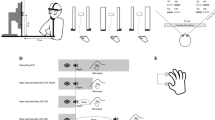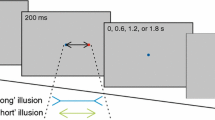Abstract
The present study explored behavioral and eye-movement measures in unilateral neglect patients in response to online bisection task (unfilled gap line). Two different tasks supported the bisection performance, a pointing and a grasping strategy. It was explored whether these different strategies may influence subjects’ behavioral and eye-movement measures in response to different segment features: segment length (from shorter to longer) and segment spatial dislocation (from right to left spatial location). Consistent spatial biases were found for both bisection responses, fixation count, and duration, as well as for the first fixation count in case of pointing task. An “extreme-left” gradient effect was suggested and discussed, with patients’ behavioral and eye measures more impaired. On the contrary, the patients’ performance overlaps with the controls’ one in case a grasping task. The direct link of visual pointing and grasping strategy, respectively, with the two cortical ventral and dorsal pathways was adduced to explain our results.



Similar content being viewed by others
Explore related subjects
Discover the latest articles, news and stories from top researchers in related subjects.References
Bisiach E, Vallar G (1988) Hemineglect in humans. In: Boller F, Grafman J (eds) Handbook of neuropsychology. Elsevier, Amsterdam, pp 195–222
Coulthard E, Parton A, Husain M (2006) Action control in visual neglect. Neuropsychologia 44:2717–2733
McIntosh RD, McClements KI, Dijkerman HC, Milner AD (2004) “Mind the gap”: the size-distance dissociation in visual neglect is a cueing effect. Cortex 40:339–346
Milner AD, Goodale MA (1995) The visual brain in action. Oxford University Press, Oxford
Van der Stigchel S, Nijboer TC (2010) The imbalance of oculomotor capture in unilateral visual neglect. Conscious Cogn 19:186–197
Conflict of interest
This supplement was not sponsored by outside commercial interests. It was funded entirely by ECONA, Via dei Marsi, 78, 00185 Roma, Italy.
Author information
Authors and Affiliations
Corresponding author
Rights and permissions
About this article
Cite this article
Balconi, M., Sozzi, M., Ferrari, C. et al. Eye movements and bisection behavior in spatial neglect syndrome: representational biases induced by the segment length and spatial dislocation of the stimulus. Cogn Process 13 (Suppl 1), 89–92 (2012). https://doi.org/10.1007/s10339-012-0465-9
Published:
Issue Date:
DOI: https://doi.org/10.1007/s10339-012-0465-9





